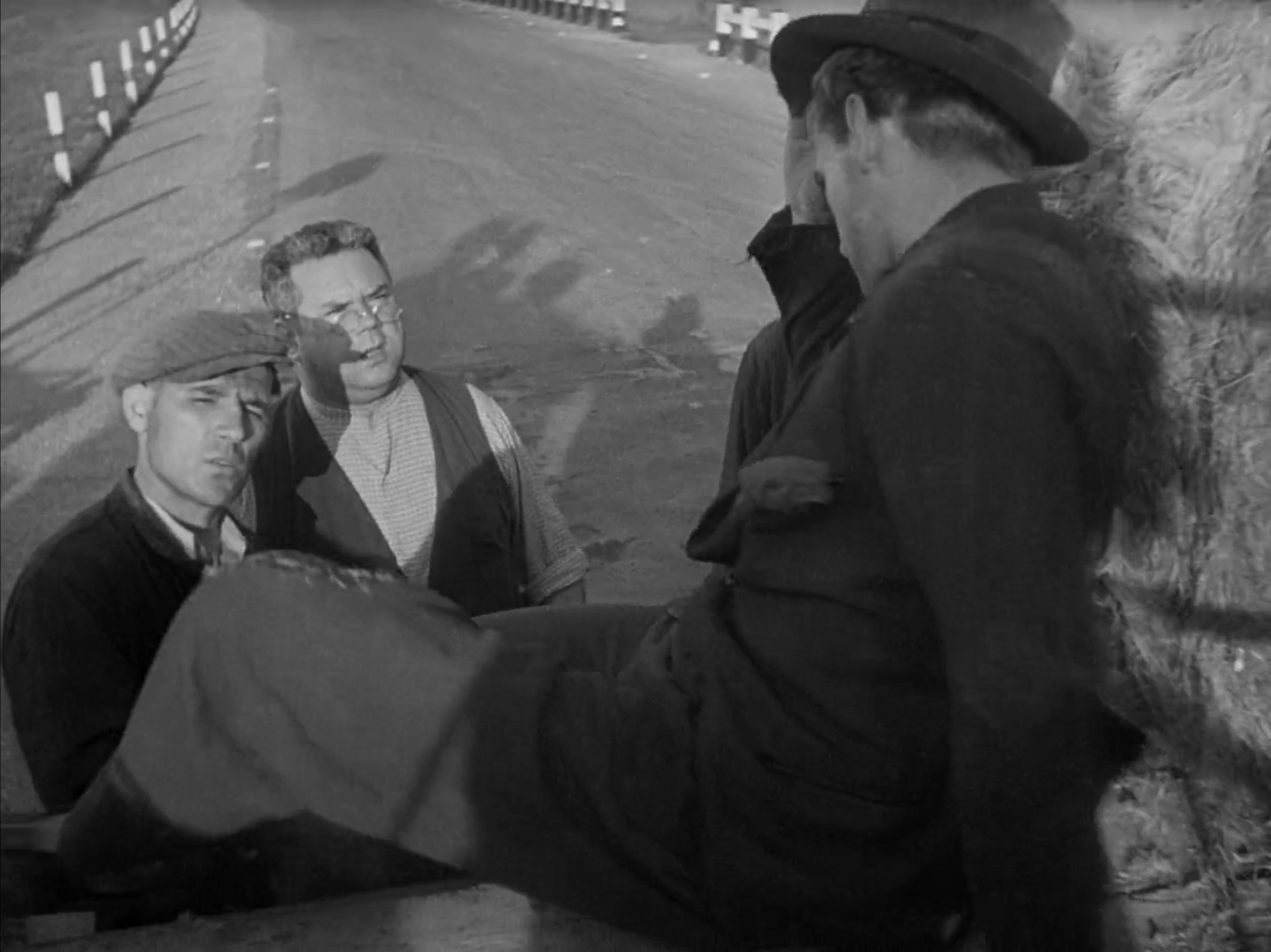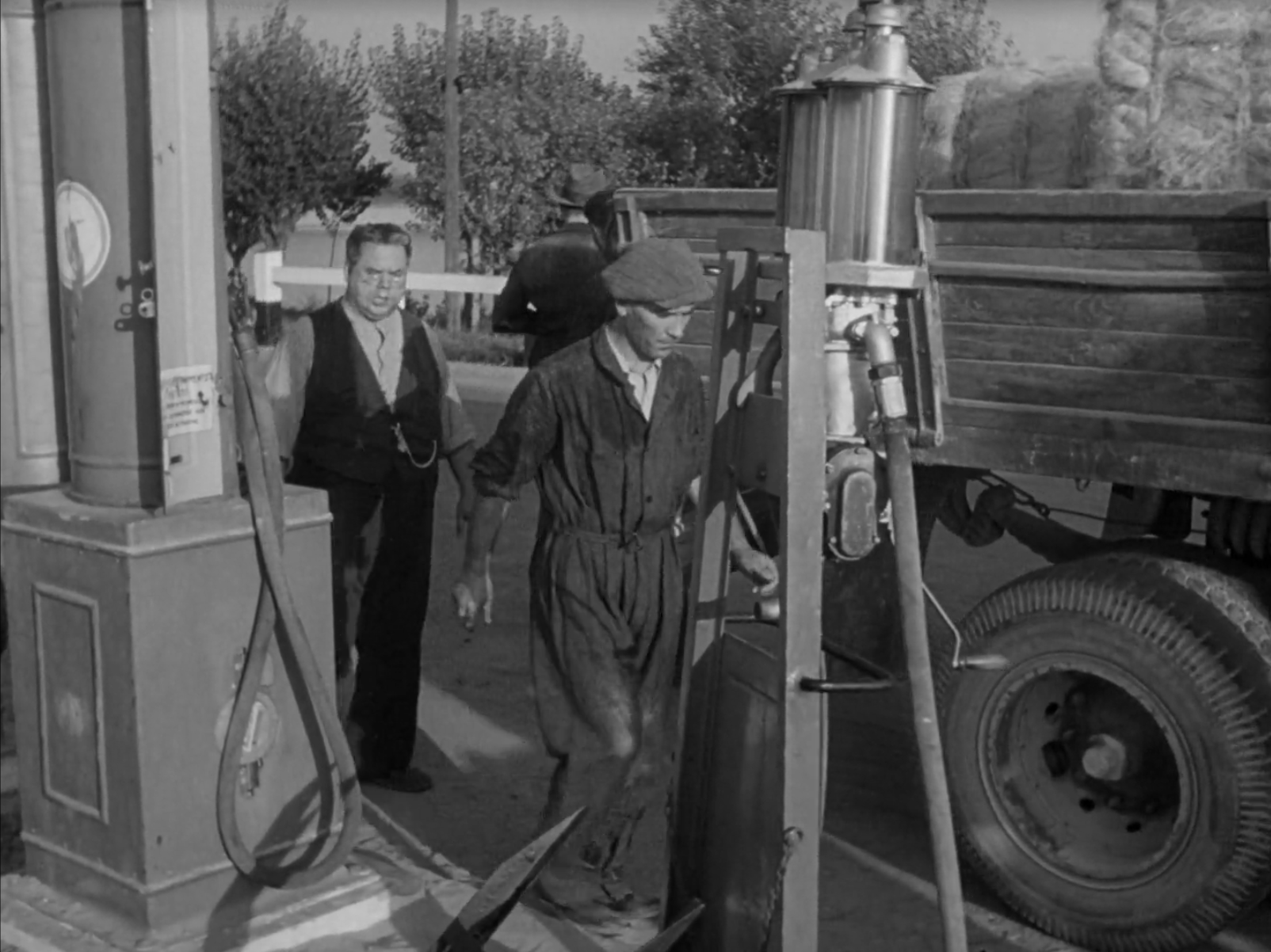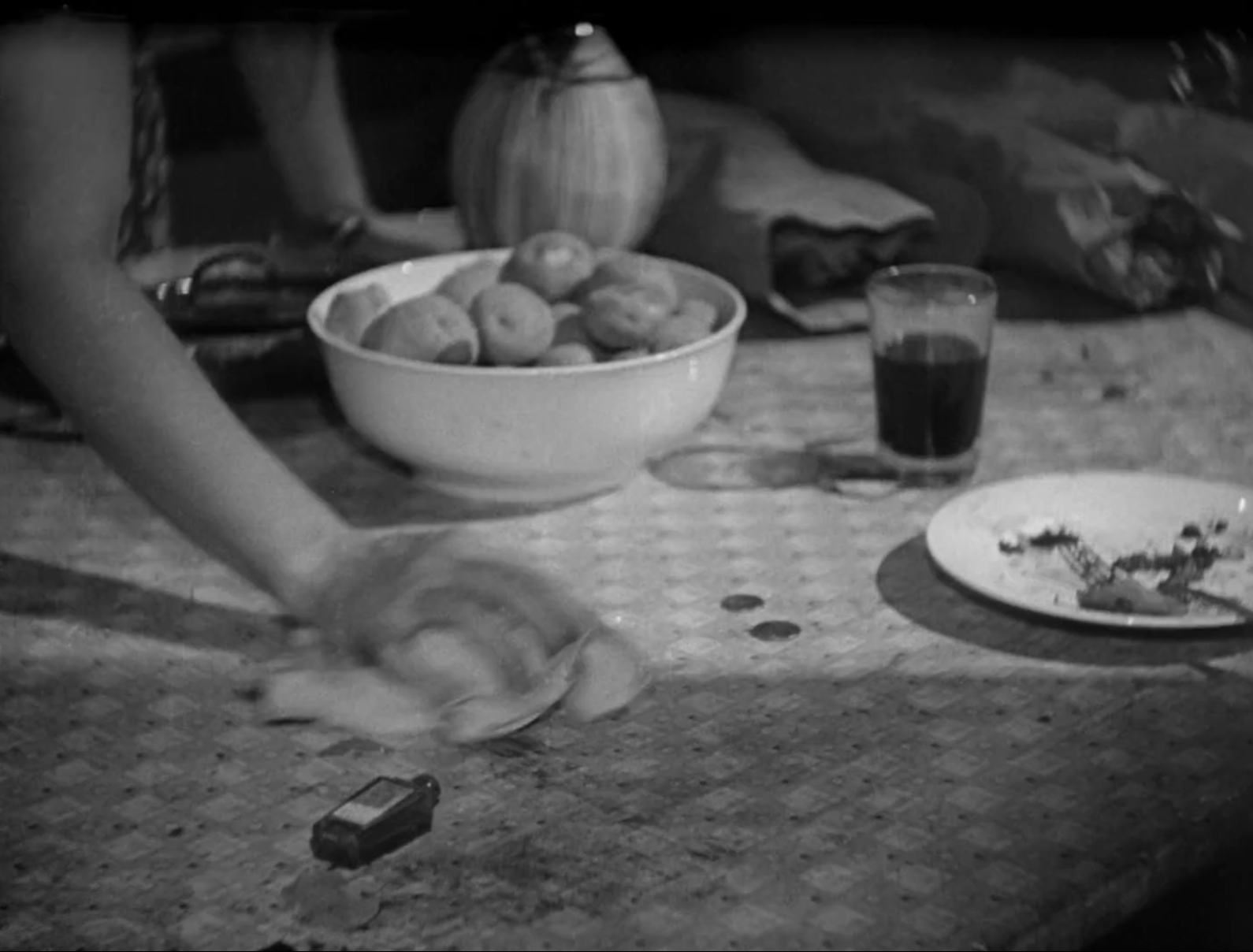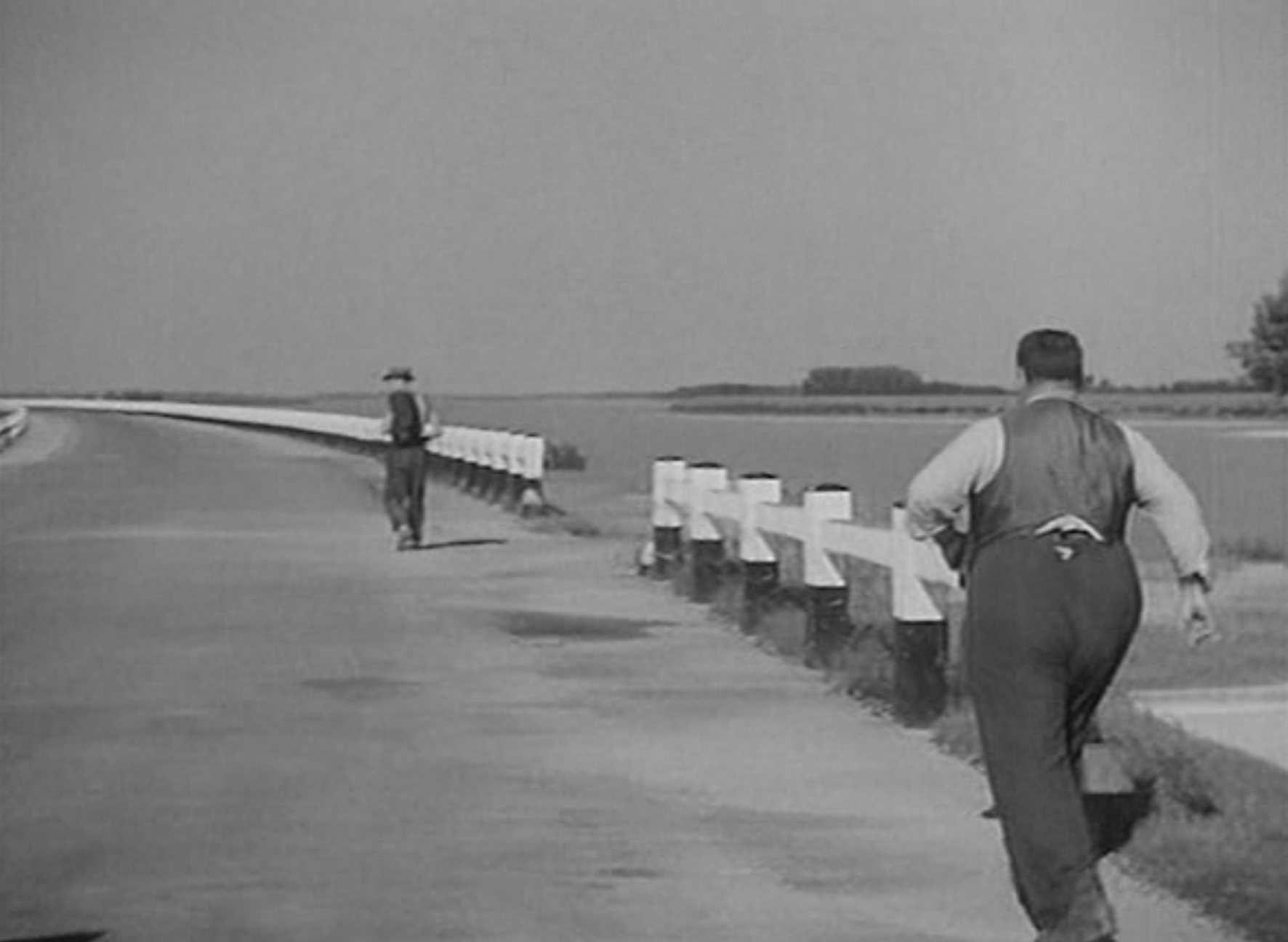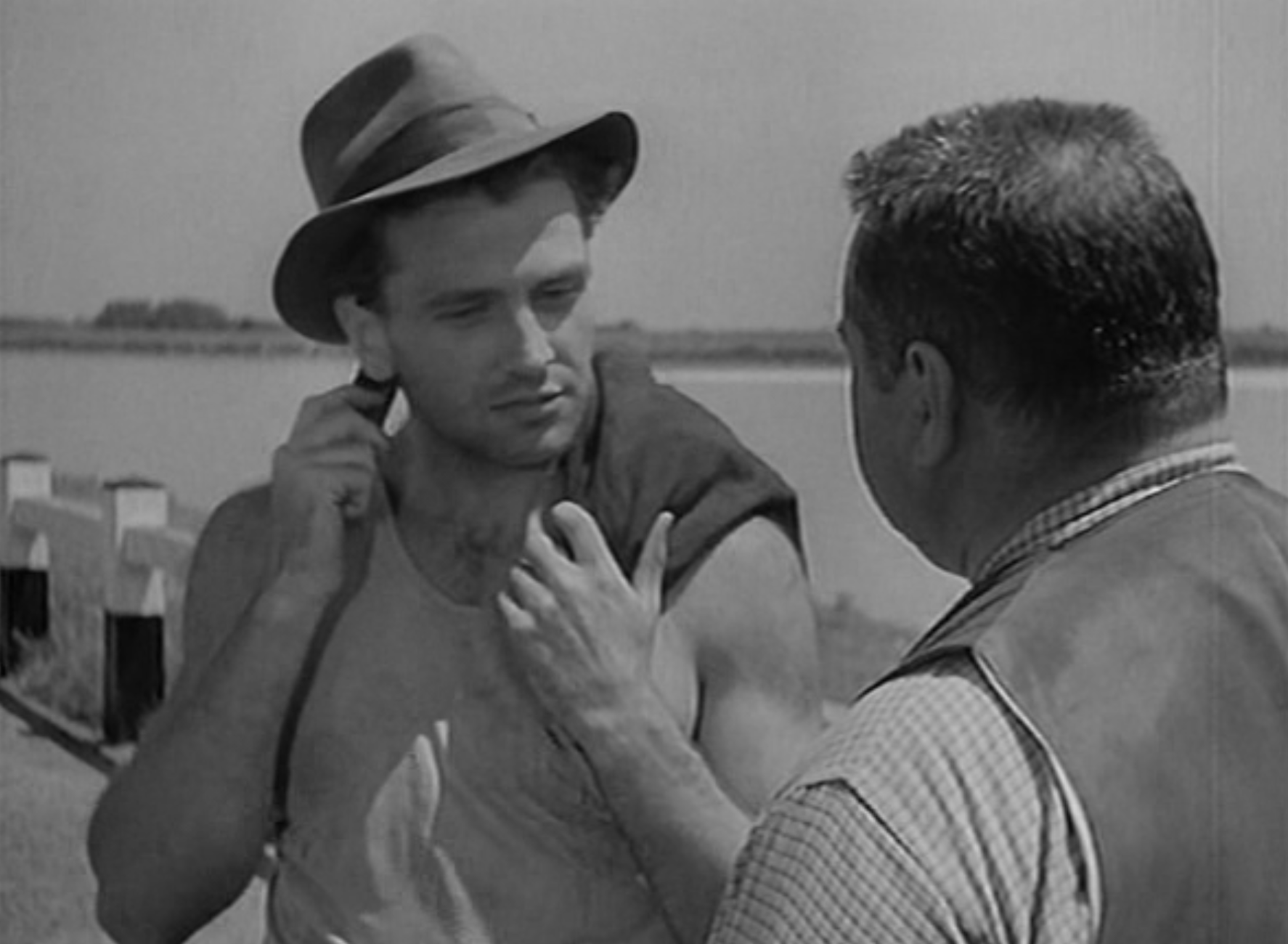Regia / Director: Luchino Visconti, 1943
Sceneggiatura / Screenplay: Mario Alicata, Giuseppe De Santis e Gianni Puccini
Fotografia / Cinematography: Domenico Scala e Aldo Tonti
Storia / Story: James M. Cain, Il postino suona sempre due volte / The Postman Always Rings Twice, 1946
Nella sequenza del titolo di questo melodramma noiresco, un camion percorre una strada desolata lungo il Delta del Po. Attraverso il parabrezza, guardiamo il paesaggio scorrere, come se fossimo seduti accanto all'autista. La cruda sequenza crea l'atmosfera per OSSESSIONE che ha rivoluzionato il cinema Italiano con le riprese in esterni, i protagonisti della classe operaia e la loro passione intensa.
In the title sequence of this noirish melodrama, a truck drives along a desolate road in the Po Delta. Through the windshield, we watch the landscape roll by, as if we are sitting beside the driver. This gritty sequence sets the mood for OSSESSIONE, which revolutionized Italian filmmaking with location shooting, working-class protagonists, and their consuming passion.
Il camion si ferma davanti alla trattoria e stazione di rifornimento di Bragana. In piedi sulla porta, Bragana (Juan da Landa) saluta l'autista, che ha fretta. "Guido da stanotte e devo arrivare a Pesaro prima di mezzogiorno".
The truck stops outside Bragana’s tavern and gas station. Standing in the doorway, Bragana greets the driver, who is in a hurry. “I’ve been driving since last night and have to get to Pesaro before noon.”
I due uomini trovano un vagabondo (Massimo Girotti) che dorme nel retro del camion. L'autista lo sveglia: "Scendi!"
Mentre il veicolo viene rifornito, il vagabondo – di nome Gino – si allontana, senza che nessuno se ne accorga.
The two men find a drifter sleeping in the back of the truck. The driver wakes him: “Get down!”
While the vehicle is being refueled, the drifter – named Gino – wanders off, without anyone noticing.
In un campo lungo, vediamo Gino che si avvicina alla trattoria. Poi la macchina da presa segue i suoi piedi, che si dirigono all'interno, seguiti da uno o due cani. Si imbatte in Giovanna (Clara Calamai), seduta a mettersi lo smalto sulle unghie, con le gambe dondolanti, cantando tra sé e sé.
In a long shot, we see Gino approach the tavern. Then the camera follows his feet, which head inside, trailed by a dog or two. He comes upon Giovanna, who sits polishing her nails, legs swinging, singing to herself.
Gino chiede un pasto.
Ecco il primo di una serie di sguardi femminili che ci sono nel film – cioè la vista di Gino dalla prospettiva di una donna. Quasi tutti i film sono girati da uomini eterosessuali e rappresentano i corpi delle donne in un modo superficiale, o anche predatorio, che è stato catalogato come lo sguardo maschile. Dato che il regista Luchino Visconti era gay, possiamo immaginare che lui stesso stia guardando il suo protagonista maschile. In questa scena abbiamo un'intersezione dello sguardo femminile e dello sguardo queer.
Andando controcorrente rispetto alla cultura patriarcale, Visconti ci fa vedere Gino dalla prospettiva di una donna. Questa prospettiva e il suo includere gli italiani comuni e le persone emarginate come protagonisti della sua storia segnalano che Visconti – nel 1945 – sta facendo un film implicitamente antifascista.
Gino asks for a meal.
Here’s the first in a series of female gazes in this film – that is, an observation of Gino from a woman’s perspective. Most films are made by heterosexual men and they represent women’s bodies in a superficial, or even predatory, way that has been characterized as the male gaze. Given that Director Luchino Visconti was gay, we can imagine he himself is gazing at his male lead. In this scene, we have an intersection of the female gaze and the queer gaze.
Going against the grain of the patriarchal culture, Visconti lets us see Gino from a woman’s perspective. That perspective and his inclusion of ordinary Italians and outsiders as the protagonists of his story signal that Visconti – in 1945 – is making an implicitly anti-fascist film.
"Io pago".
"Va bene, ma si mangia di là".
Lui la ignora e si serve con un assaggio di quello che lei sta cucinando. Lui chiede se lei ha qualcosa a che fare con il tipo grasso fuori.
"È mio marito".
"È fortunato ad avere una donna come te", risponde lui.
“I’ll pay.”
“Fine, but you eat in the other room.”
He ignores her, and helps himself to a taste of what she’s cooking. He asks if she has anything to do with the fat guy outside.
“He’s my husband.”
“He’s lucky to have a woman like you,” he replies.
Altri sguardi. Quando Gino si toglie la giacca, la canottiera fa poco per nascondere il suo corpo muscoloso. Lui incontra lo sguardo di lei senza esitazioni. Dopo aver mangiato, mette qualche moneta sul tavolo come pagamento.
More gazes. When Gino takes off his jacket, his undershirt does little to conceal his muscled body. He meets her gaze unflinchingly. After he’s eaten, he puts a few coins on the table in payment.
Entrando, Bragana si lamenta della presenza di Gino in cucina. Il vagabondo se ne va.
Entering, Bragana complains about Gino’s presence in the kitchen. The drifter leaves.
Giovanna dice a suo marito che Gino se n'è andato senza pagare e Bragana lo insegue lungo la strada accanto al fiume per recuperare i suoi soldi.
Grattandosi il collo con la sua armonica, Gino è divertito dalla piccola bugia di Giovanna.
Giovanna tells her husband that Gino left without paying, and Bragana chases him along the road beside the river to get his money.
Scratching his neck with his harmonica, Gino is amused by Giovanna’s little lie.
Non ha soldi, ma si offre di lavorare per pagarlo e Bragana accetta. A quanto pare Gino è un meccanico.
"Non sei proprio un vagabondo", osserva Bragana.
"Mi piace viaggiare".
Alla macchina, Gino smonta un pezzo e lo nasconde in tasca per assicurarsi che la riparazione richieda del tempo. Bragana andrà in città a prendere il ricambio.
He has no money, but he offers to work it off, and Bragana accepts. It seems that Gino is a mechanic.
“You’re not really a tramp,” observes Bragana.
“I like to travel.”
At the car, Gino removes a part and hides it in his pocket to ensure that the repair will take some time. Bragana will go into town to get the replacement.
Bragana e il prete vanno in città in bicicletta. Questa inquadratura ben composta lungo il fiume è la prima di molti panorami del Delta del Po, dove si trova la trattoria e dove inizia la nostra storia.
Bragana and the priest go into town by bicycle. This beautifully composed shot along the river is the first of many vistas of the Po Delta, where the tavern is located and our story begins.
Gino sta aggiustando la pompa dell'acqua, ma è distratto da una canzone d'amore che Giovanna sta cantando all'interno della trattoria:
...Viene come la brezza per un momento e poi se ne va.
Ma quando sei con me, sono felice perché
L'amore è bello con te
Gino is fixing the water pump, but he’s distracted by a love song that Giovanna sings inside the tavern:
...It comes like the breeze for a moment and then it goes.
But when you’re with me, I’m happy because
Love is beautiful with you
Gino smette di lavorare. Questa sequenza mostra quella che è certamente una delle canottiere più memorabili del cinema italiano.
Gino stops working. This sequence features what is certainly one of the most memorable undershirts of Italian cinema.
Gino va verso la porta aperta, controlla che nessuno stia guardando ed entra, chiudendola dietro di sé.
Gino walks to the open door, checks that no one is watching, and enters, closing it behind him.
FINE PARTE I
Here is Parte II of this cineracconto. Subscribe to receive a weekly email newsletter with links to all our new posts!
A note about the translation: In writing our photo-stories, we aim for a fluid, standard Italian – though in places, it might seem more basic than how an average Italian would speak. Then we write an English translation – which is naturally also at an intermediate level of English. Our photo-stories written prior to September 2021 were at a higher level of Italian and the translation was more literal, as a tool to assist Italian learners understand the text. However, starting with this photo-story – with its side-by-side translation – we are using a “literary,” rather than a literal translation. The English translation actually sounds like how people talk, which means that it is a more accurate translation.
While our past photo-stories included nearly all the dialogue verbatim from our films, starting with OSSESSIONE, we are writing a more abbreviated version of the story. As before, the dialogue reflects the actual spoken dialogue of the film.
Where subtitles offer good examples of standard intermediate-level Italian that can be useful to language learners, we’ve included them for fun!
As for specific language in this film, we’ve changed “spaccio” to “trattoria,” more accurately describing the place in present-day parlance. Note, there is a sign on the front of the place identifying it as a trattoria.
We love language and we sometimes spend a very long time debating a particular word or phrase. We’d be very happy to hear your thoughts about our translations. Write to us at info@liconoscevobene.net!








